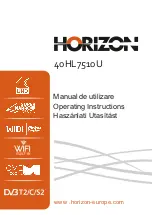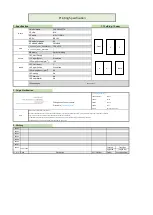
Service Modes, Error Codes, and Fault Finding
EN 15
EBJ1.0U
5.
5.
Service Modes, Error Codes, and Fault Finding
Index of this chapter:
5.1 Test Points
5.2 Service Modes
5.3 Service Tools
5.4 Error Codes
5.5 The Blinking LED Procedure
5.6 Protections
5.7 Fault Finding and Repair Tips
5.8 Software Upgrading
5.1
Test Points
As most signals are digital, it will be almost impossible to
measure waveforms with a standard oscilloscope. Therefore,
waveforms are not given in this manual. Several key ICs are
capable of generating test patterns, which can be controlled via
ComPair. In this way it is possible to determine which part is
defective.
Perform measurements under the following conditions:
•
Service Default Mode.
•
Video: Color bar signal.
•
Audio: 3 kHz left, 1 kHz right.
5.2
Service Modes
Service Default Mode (SDM) and Service Alignment Mode
(SAM) offer several features for the service technician, while
the Customer Service Mode (CSM) is used for communication
between a Customer Helpdesk and a customer.
There is also the option of using ComPair, a hardware interface
between a computer (see requirements below) and the TV
chassis. It offers the ability of structured troubleshooting, test
pattern generation, error code reading, software version
readout, and software upgrading.
Minimum
requirements for ComPair: a Pentium processor,
Windows 95/98, and a CD-ROM drive (see also paragraph
“ComPair”).
5.2.1
Service Default Mode (SDM)
Purpose
•
To create a pre-defined setting, to get the same
measurement results as given in this manual.
•
To override SW protections (only applicable for protections
detected by stand-by processor) and make the TV start up
to the step just before protection (a sort of automatic
stepwise start up). See paragraph “Stepwise Start Up”.
•
To start the blinking LED procedure (not valid in protection
mode).
Specifications
Table 5-1 SDM default settings
•
Tuning frequency 61.25 MHz for NTSC: The TV shall tune
to physical channel 3 only if channel 3 is an analog channel
or if there is no channel 3 installed in the channel map. If
there is a digital channel installed in channel 3, then the
frequency to which the set will tune, would be as specified
in the channel map and could be different from the one
corresponding to the physical channel 3.
•
All picture settings at 50% (brightness, color, contrast).
•
All sound settings at 50%, except volume at 25%.
•
All service-unfriendly modes (if present) are disabled, like:
–
(Sleep) timer.
–
Child/parental lock.
–
Picture mute (blue mute or black mute).
–
Automatic volume levelling (AVL).
–
Auto switch "off" (when no video signal was received
for 10 minutes).
–
Skip/blank of non-favorite pre-sets.
–
Smart modes.
–
Auto store of personal presets.
–
Auto user menu time-out.
How to Activate SDM
Use one of the following methods:
•
Use the standard RC-transmitter and key in the code
“062596”, directly followed by the “MENU” button.
Note:
It is possible that, together with the SDM, the main
menu will appear. To switch it "off", push the “MENU”
button again.
•
Short for a moment the two solder pads [1] on the SSB,
with the indication “SDM”. They are located outside the
shielding. Activation can be performed in all modes, except
when the set has a problem with the Stand-by Processor.
See figure “SDM and SPI service pads”.
Figure 5-1 SDM and SPI service pads 1/2
Figure 5-2 SDM and SPI service pads 2/2
After activating this mode, “SDM” will appear in the upper right
corner of the screen (if you have picture).
Region
Freq. (MHz) Default system
NAFTA, AP-NTSC, LATAM 61.25 (ch. 3) NTSC M
G_15860_079.eps
100406
SDM
SPI
SDM
SPI
G_15860_080.eps
100406
SDM
SPI
SPI
SDM
Summary of Contents for EBJ1.0U
Page 166: ...Revision List EN 166 EBJ1 0U 11 ...
















































